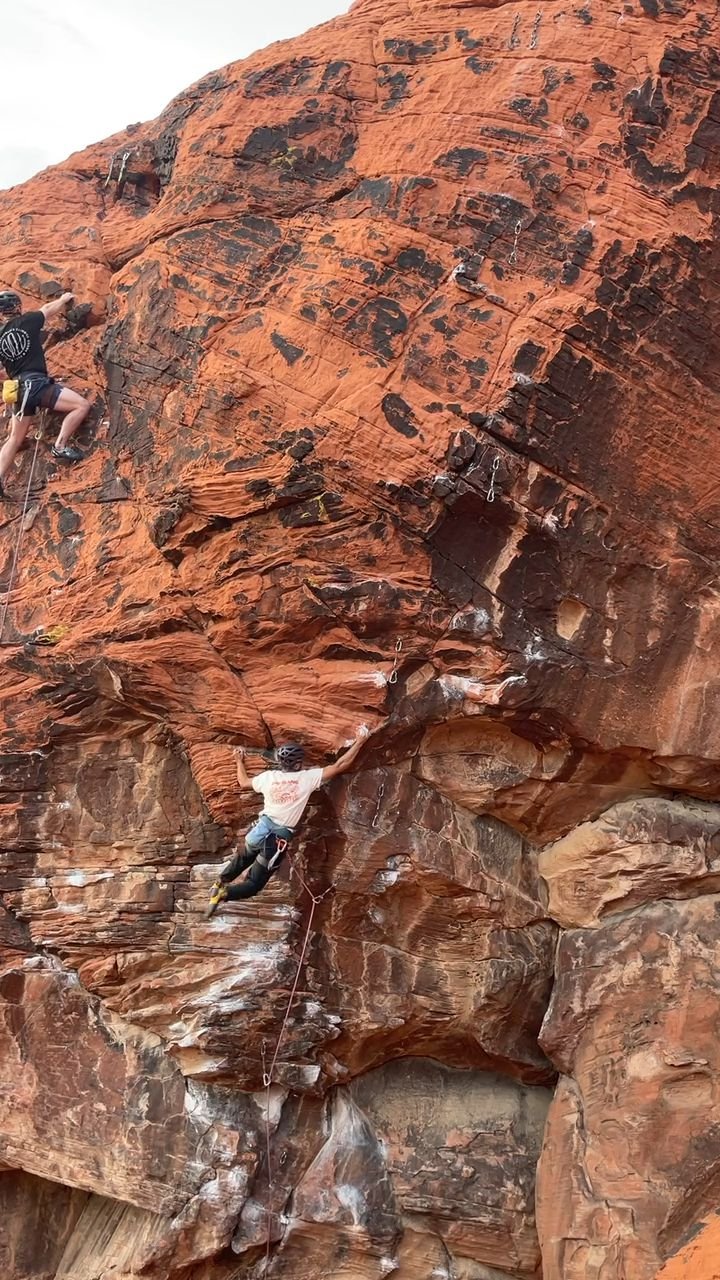my fourteen projecting defaults
Originally published on Unsend It.
Ah, fall season. Cool weather is currently struggling to find its way to the West Coast. Any day now please.
Dyno’ing to the good hold on Fear and Loathing III, in Red Rocks last Friday. Two hung it, so it’ll definitely be one of my fall projects!
Like many other climbers right now, I’m getting stoked for the fall. And my outdoor projects.
If you’re not a climber, to project is to work on a difficult climb that’s right at the limit of your skillset. Projecting is, by definition, difficult. And fulfilling. Because you achieve something you thought you weren’t capable of.
I wanted to share my current “defaults” for projecting as I enter projecting mode this season. These are just reminders to myself, as well as a way to see how they change as I continue to grow.
I’m not a pro. But when I climb outside, I primarily project boulders and (more recently) sport routes.
Don’t read these as “rules.” They’re not rigid. They’re defaults.
The default settings on your phone dictate how your phone works. But you can change them in the Settings! You can change defaults, but there has to be good reason to change them. And if you don’t have good reason to change them, you use the default.
My current projecting defaults
Don’t just research the climb. Do research the approach, ascent, descent, and downclimb. ⤵️ (1)
Don’t think you won’t need an extra pad, a spotter, or the first bolt clipped. Do everything it takes to prevent yourself from getting injured. ⤵️ (2)
Don’t make failure about you. Do try to learn from failure.
🙅🏽 “I’m not sending, therefore, I’m not strong enough to send this.”
😎 “What caused my fall? What can I do differently?”
Don’t wait for the perfect conditions. Do go when the conditions are good enough. ⤵️ (3)
Don’t compare yourself to others also working on your project. Do compare beta so that y’all can learn from each other. ⤵️ (4)
Don’t use other people’s performance as a baseline for where you should be. Do use your past self as a baseline.
Don’t project alone. Do project with a partner.
Don’t let the grade define you (chances are, it’s made up by some tall white guy). Do let the grade challenge you.
Don’t waste energy! Do get the moves down in sections.
Don’t spend all day on moves you can’t do. Do limit your goes to get as much information as possible. ⤵️ (5)
My climbing partner Joe put this simply: “Make your goes count.”
Don’t suppress how you feel if you fail. Do make space to feel before strategizing. ⤵️ 6
Don’t overly self-deprecate. Do acknowledge the effort you put in.
🙅🏽 “I suck as a climber. I’m not sending.”
😎 “I didn’t hit my goal but I’m proud I showed up today.”
Don’t suppress your wants. Do own that you do want to send it.
Don’t make your entire life about one project. Do have a secondary project. Or routes/boulders you can send in under 5 attempts.
Again, you can deviate from these defaults, but you must have good reason to. I’ve deviated from 7: “Don’t project alone. Do project with a partner.” When I did, I reasoned that the boulder was low enough for me to work solo.
Every climber who projects has their own defaults. If you’re a climber, think about what yours are. Which defaults resonate with you? What would you disagree with? What would you add?
If you aren’t a climber, I’m curious if you’re doing anything difficult. You might be trying to create proof that you can do hard things. What’s your “hard project”? Which defaults might help you?
LA Climbers: Philippines Climb Night, 10/25 @ The Post
If you’re based in LA and here next week, come to The Post next Wednesday. 5:30-9! I’m helping organize an event there.
Al, a route setter in Cebu, will share about the climbing scene in Danao, Cebu. As a Filipino American who visits the Philippines often, I’m stoked to learn about what the climbing is like in the motherland.
Share the event on Instagram, too.
Footnotes
↪️ (1) From reading Accidents in North American Climbing, I’m learning that tons of rescues happen on the ascent/descent. Multi-pitch climbers will focus their planning on the climb itself and not much on the ascent/descent. From my personal experience as a boulderer, boulderers (myself included) will often not look at the down climb before doing the project.
↪️ (2) My first time climbing outside, I climbed this V1 at The Gunks, sent it, and dropped down ~12 feet into a small Metolius pad with 3 spotters. While my left foot hit the pad, my right foot missed it, shattering my talus bone. I was out for 4 months. The Gunks guidebook calls this V1 “The Warmup” so I like to joke that I broke my ankle on The Warmup climbing outside for the first time.
↪️ (3) Of course, I try my best to line up all the factors: good sleep, good weather, proper fuel, good crew. I’m just mindful of when I (and other climbers) say things like “Fuck, I’m not getting past the crux. Must be because .” I mean, you might be right. But consider you may not be doing the crux because you don't have the beta yet. That's it.
↪️ (4) “Comparison can actually be used positively.” From Faith’s IG post.
↪️ (5) I like how Tyler Nelson says “the best climbers in the world are good at getting more information from fewer tries.”
↪️ (6) This is a new one for me. I’m practicing feeling disappointed when I’m disappointed, and telling that to other people when they ask me how my project went. Usually I’m like “well, it didn’t go, but excited to try a new move next time.” But giving myself the proper space to feel disappointed is okay!

